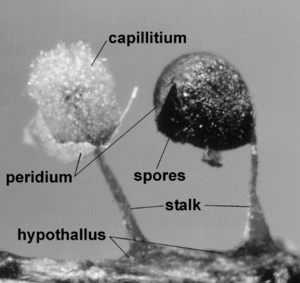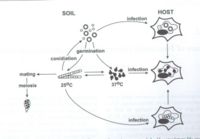Myxogastria
A Microbial Biorealm page on the Myxogastria

Classification
Higher order taxa
Eukaryota; Mycetozoa
Species
Lycogala epidendrum
Fuligo septica
Physarum penetrale
|
NCBI: Taxonomy Genome |
Description and Significance
Myxogastria are plasmodial slime molds, although they were previously thought to be fungi. They produce fruiting bodies that resemble those created by higher fungi. There are roughly 1,000 known species. Fiore-Donno et. al. (2005) have proposed three groups of Myxogastria: Echinosteliales, Liceales and Trichiales, and Physarales and Stemonitales. Echinosteliales have the most in common with Protostelida. They have unpigmented or only slightly pigmented spores. Liceales and Trichiales have clear, pigmented spores. Physarales and Semonitales have dark spores.
The research of Nakagaki et. al. (2004) illustrates that Myxogastria is capable of "intelligent" behavior. An earlier study by these researchers demonstrates that the species Physarum polycephalum is capable of finding the shortest route to food through a maze. The 2004 study backs up this original data. This research also showed that Physarum polycephalum is capable of shaping its body to absorb as many nutrients as possible when presented with multiple food sources. It does so by spreading out its body to cover every source, connecting itself with tubular elements. These findings imply that Physarum polycephalum can solve a complex problem.
Genome Structure
There is not yet an extensive body of research on the genome structure of Myxogastria.
Cell Structure and Metabolism
Although the fruiting bodies of Myxogastria resemble the bodies of higher fungi, they are considerably smaller. Their mitochondria have tubular cristae. They use pointed pseudopodia for movement and for capturing food. Myxogastria have diploid nuclei. These organisms are pigmented with bright colors. In the plasmodium stage, Myxogastria are covered by a membrane, but is not enclosed in a cell wall. Spores actually develop cellulose walls. When germination occurs, this wall cracks to release the new cell. In adverse conditions, Myxogastrica can form cell walls to protect themselves. This wall is called they microcyst.
Myxogastria feed off of bacteria and organic matter. They are heterotrophic organisms and obtain their food by engulfing it with pseudopodia.
There are two different stages to the life cycle. The first part consists of a uninucleate amoebae, and the second part consists of a multinucleate structure called the plasmodium. Thist stage is unicellular; it is a mass of cytoplasm. To enter this stage, cells aggregate and fuse completely to form a single cell. Individual cells will only aggregate after gamete fusion, which forms diploid cells. Myxogastria will produce fruiting bodies (spores). These spores can be smooth, but are usualy ornamented. Ornamentations can inlucde spines, warts, or ridges. The spores are dispersed by the wind or insects, and germinate to produce more uninucleate cells.
Ecology

Myxogastria are found in the soil of moist environments, typically forests. A few species can be found in almost any ecosystem. During the plasmodial stage, they can be found in shady environments such as decaying wood. Myxogastria play a role in the carbon cycle because they help decompose decaying plant matter. It is believed that individual cells aggregate only when they lack sufficient nutrients.
References
Abedon, Stephen T. Myxogastrida (plasmoidial slime molds). 25 March 2005.
Pitocchelli, Jay. Survey of representatives of the major Kingdoms.
Stephenson, Steven. "Myxomycetes and other Slime Molds." Discover Life. 12 April 2005.

